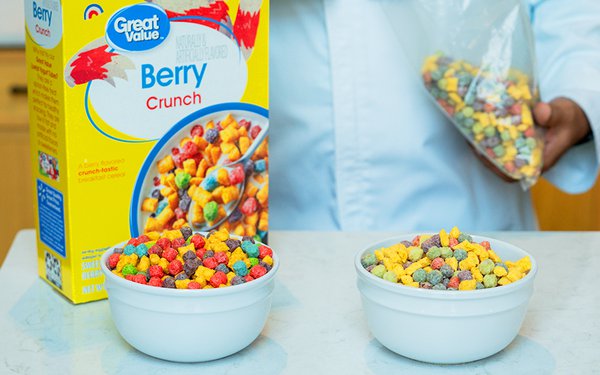
Image above: Walmart's
Great Value private-label line
Amazon and Walmart keep trying to redraw the rules of grocery. Amazon just launched Amazon Grocery, a sweeping private-label line with more than 1,000
budget-priced items. Walmart, in a nod to the “Make America Healthy Again” movement, is cutting synthetic dyes and more than 30 other additives from its house brands.
Both shifts
reflect mounting pressure on food retailers. Consumers are squeezed by inflation, bracing for $186 billion in SNAP cuts that will affect 14% of U.S. households, and scanning ingredient labels more
closely than ever. At the same time, Walmart continues to attract higher-income shoppers looking for bargains, while Amazon leans on convenience and price to win more online orders.
The new
Amazon Grocery brand unites two of Amazon’s existing private-label lines, Happy Belly and Amazon Fresh, under a single umbrella. The assortment spans fresh produce, dairy, meat, seafood, snacks,
pantry staples and bakery goods. Most items are priced under $5 and carry customer ratings of four stars or higher.
advertisement
advertisement
“During a time when consumers are particularly price-conscious, Amazon
Grocery delivers more than 1,000 quality grocery items across all categories that don’t compromise on quality or taste — all at low, competitive prices that help customers stretch their
grocery budgets further,” said Jason Buechel, vice president of Amazon Worldwide Grocery Stores and CEO of Whole Foods Market, in the announcement.
Sales of Amazon’s private-label
products grew 15% last year across Amazon.com, Whole Foods Market and Amazon Fresh. The company is also touting sustainability, with new packaging that cuts plastic use in some categories by 50% and
emphasizes clearer nutrition labeling.
Walmart is taking the opposite tack: subtraction. Its private-brand foods, including Great Value, Marketside, Freshness Guaranteed and bettergoods, are
being reformulated without synthetic dyes, artificial sweeteners, certain preservatives and fat substitutes.
“Our customers have told us that they want products made with simpler, more
familiar ingredients — and we’ve listened,” said John Furner, Walmart U.S. president and CEO, in the press release. “By eliminating synthetic dyes and other ingredients,
we’re reinforcing our promise to deliver affordable food that families can feel good about.”
He noted that 90% of Walmart’s private-brand food products are already dye-free.
The full reformulation effort, which Walmart says will be one of the largest in retail history, will roll out in phases through January 2027.
Both changes come at rocky times for grocery
retail.Oppenheimer & Co. analyst Rupesh Parikh expects the grocery environment to remain challenging, citing weaker jobs growth and Amazon’s intensifying grocery push. Still, he sees
private label as a bright spot: “Private label remains an intense focus, as consumers remain focused on value seemingly across all different income levels.”
That shift is
particularly strong among younger shoppers. Amazon research shows Gen Z-ers and millennials are adopting online grocery twice as fast as the national average, with growing demand for perishables.
The two announcements underscore how private label has become the battleground for both value and values. Amazon is chasing breadth and price. Walmart is banking on cleaner labels and cultural
resonance with MAHA-style health politics. Both are betting AI and supply-chain efficiencies can deliver the convenience and trust today’s shoppers demand.
For consumers, it adds up to a
new kind of choice: whether to buy private label for the price tag, the ingredient list — or both.